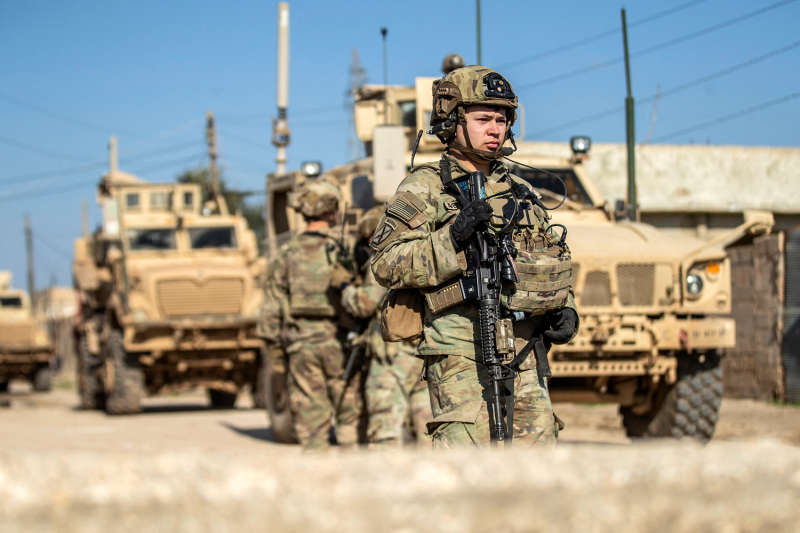The recent Iranian aerial assault on Israel marks a significant escalation in Middle Eastern tensions, bringing new risks to U.S. troops stationed in the region. This development has necessitated an urgent reassessment of security protocols and defensive measures by the Pentagon to ensure the safety of American service members across strategic locations in the Middle East, including Iraq, Syria, and the Red Sea.
The magnitude of Iran’s attack—a coordinated launch of drones and missiles—represents a severe escalation in the longstanding conflict between Iran and the United States, which supports Israel. Although none of the Iranian projectiles posed an immediate threat to U.S. personnel, the scale of the attack has prompted high-level discussions within the U.S. military about the potential for new threats to emerge against U.S. forces. These discussions highlight concerns that Iran might leverage the chaos to target American assets more aggressively, especially in scenarios where Israel responds robustly to Iranian provocations.
Senior U.S. administration officials have conveyed their concerns under conditions of anonymity, stressing the precariousness of the current situation. The U.S. has thousands of troops stationed at various vulnerable points across the Middle East, including military bases and naval vessels. These forces are considered at heightened risk given the volatility of the current geopolitical climate.
The response from the U.S. has been swift and substantial, with military maneuvers designed to fortify defenses and protect American interests in the region. This includes the deployment of additional troops and resources to bolster positions that might be susceptible to Iranian attacks. The Pentagon’s actions underscore a firm commitment to both regional stability and the safety of American military personnel.
Moreover, U.S. administration officials have been pressing Israeli leaders to exercise restraint in their response to the Iranian aggression. There is a palpable concern that a forceful retaliation by Israel could spiral into a larger conflict, inadvertently putting U.S. forces in harm’s way. This diplomatic engagement reflects an intricate balancing act for the U.S., which must support its ally Israel while also mitigating the risk of a broader regional conflict.
In terms of defensive operations, the U.S. military’s recent actions have been notable. The deployment of advanced naval destroyers, aerial fighters, and missile defense systems to intercept Iranian drones and missiles heading towards Israel demonstrates a robust defensive capability. These measures have not only thwarted immediate threats but also served as a strategic show of strength, signaling U.S. readiness to defend its interests and allies against Iranian aggression.
The success of these defensive operations has been a point of pride for the Department of Defense, with officials noting the effectiveness of the U.S. military’s tactical responses. Despite the potential for significant damage, the defenses held strong, preventing any of the Iranian projectiles from reaching their intended targets in Israel.
Looking ahead, the U.S. is preparing for the possibility of prolonged engagement in the region. Several U.S. Army ships are expected to arrive soon to begin construction on a floating pier that will facilitate the delivery of humanitarian aid to Gaza. This mission, while primarily humanitarian, carries substantial security risks, as the construction site and the supporting naval vessels will be vulnerable to attack.
The planned pier, to be anchored by the Israel Defense Forces, represents a critical infrastructure project that is susceptible to both air and ground attacks. The Pentagon is therefore planning a comprehensive security strategy to protect this and other sensitive operations in the region. This strategy includes a variety of defensive measures designed to counter potential threats from fast boats, divers, and shoulder-launched missiles, among others.
These preparations are informed by historical precedents, such as the attack on the USS Cole in 2000, which underscore the types of threats that can arise in such volatile environments. The memory of such attacks has led U.S. military planners to devise robust, layered defense systems that involve cooperation between the Navy, Army, and Israeli Defense Forces.
The U.S. military’s heightened vigilance and preparedness in the Middle East reflect a strategic response to emerging threats in a rapidly changing geopolitical landscape. The commitment to defending American interests and personnel, while supporting allies like Israel, remains a cornerstone of U.S. military strategy in the region. As tensions continue to unfold, the U.S. will likely maintain a strong defensive posture to deter aggression and ensure the safety of its forces abroad.

